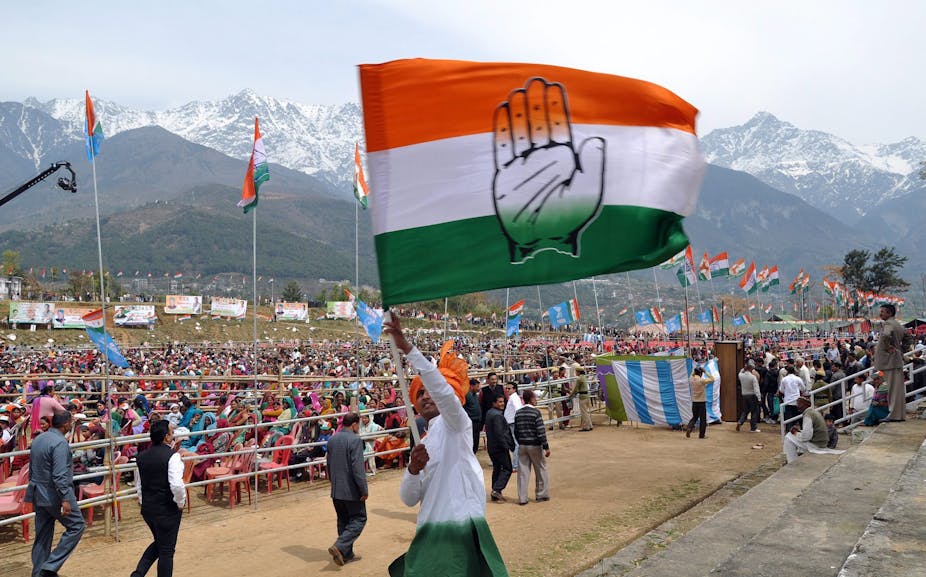In some ways, India is the world in microcosm: 1.2 billion people, more than twice the population of the European Union, and a federation of 28 states (same as the EU), plus seven union territories. The distance from Kanyakumari at the southern tip to Guwahati in the northeast is about the same as from Lisbon to Helsinki. As you travel through India, you pass through more than a dozen major languages, written in 11 different scripts.
The issue of corruption, however, cuts across all differences in Indian society. It ranges from the everyday gouges demanded by clerks and cops to corporate scandals involving vast public resources granted at bargain terms to private interests. This makes corruption possibly the biggest issue of the election.
So, with voting starting in some parts of India this weekend, what role will corruption play in deciding the outcome of the election?
A new political party has emerged out of widespread exasperation at corruption great and small. The Aam Aadmi Party (AAP, or “ordinary man’s party”) grew out of protest movements of the past three years. In December, it won 28 of 70 seats in elections to the Delhi assembly and formed a short-lived government, which resigned in February.
The AAP will run candidates in a number of seats across the country; a few may win. The AAP cannot expect to win a majority of seats, nor should any other party. Social diversity has produced minority national governments for more than 20 years.
The last time Indians gave a majority to a single party – Congress – was in 1984, in the emotional aftermath of Indira Gandhi’s assassination.
Indications are strong, however, that the Congress Party, which has led coalition governments since 2004, will lose its position as the largest single party. The Bharatiya Janata Party (BJP), a Hindu-nationalist party, is set to be the biggest winner.
However, corruption also plagues the BJP and its leader, Narendra Modi, chief minister of the state of Gujarat since 2001. The BJP is likely to win the largest block of seats in the 543-member lower house of parliament but not the 270 or so necessary for a majority in its own right.
Modi and his party stand for an uncompromisingly Hindu India. They proclaim that the interests of Hindus (more than 80% of the population) have been constantly sacrificed and that minorities, especially Muslims but also Christians, have been pandered to. A muscular Hindu India, they argue, will allow India to prosper and assume its rightful place in the world.
Modi has the dubious distinction of having been chief minister of Gujarat in 2002 when hundreds of Muslims were murdered in retaliation for the torching of a railway carriage and the death of more than 50 Hindu pilgrims by a Muslim mob in a rural railway station. Modi’s government and police stood by while mob retaliation went on across the state for days.
Critics claim the state government encouraged the carnage, but Modi has been absolved by law for any complicity.

Big business also approves of Modi and sees Gujarat as one of the two or three efficient states in the country. Roads are comparatively good; electricity reliable; red tape limited. If India’s business organisations were determining the outcome of these elections, Modi would win.
Modi’s reputation as someone capable of devising and implementing policy stands in contrast to the perceived record of the Congress-led government. The latter has some achievements, but its failures are better known. Its biggest developmental expenditure has been the Mahatma Gandhi National Rural Employment Guarantee Act (MGNREGA), which gives every Indian a right to be employed for 100 days a year at a basic wage of about 100 rupees (A$1.80) a day.
Its backers argue that MGNREGA, and similar broad-based social programs, are transforming the countryside and giving millions of poor rural people security, health and nutrition never before possible. Its detractors argue that the program creates useless, disconnected public works, is riddled with corruption and represents an attempt by the Congress party to buy votes with handouts. Employers complain that the cost of labour has increased now that people have a source of basic employment near their home villages.
The Congress government highlights its Right to Information Act of 2005, which has improved government accountability, and electronic reporting which has improved the delivery of some services. However, there are no big successes for the incumbents to brag about.
The Delhi 2010 Commonwealth Games left a trail of accusations and damaged reputations. Big corporate and government projects are stalled, while ordinary people – the “aam aadmi” – see few benefits in their daily lives. Inflation is 8% and annual economic growth has fallen to less than 5%, about half of what had been achieved at the beginning of the century.
India’s diversity means this election is a series of largely independent battles in various states. Half-a-dozen state chief ministers or ex-chief ministers head powerful local parties and imagine themselves sitting in the prime minister’s chair at the head of a coalition government in May. If they lead 20 or 30 MPs to Delhi, they will have a role in the horse-trading to form the new government.
Outsiders have got the top job – briefly – in the past. But they will first have to overcome the BJP and Narendra Modi.
Modi celebrates his lower-caste background and his early job in a teashop. For years, he has been crafting a story about how a strong, honest leader, devoted to Hindu values and familiar with the struggles of the poor, can bring purposeful, achievement-oriented government.
Lots of Gujaratis drank Modi’s tea in the past. It will be clear only after the votes are counted on May 16 how many Indians have drunk the current electoral Kool-Aid.

